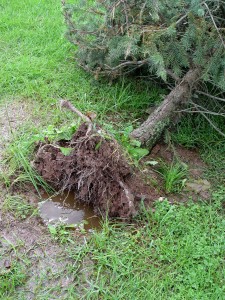Surviving the Sog
April 26th, 2011
Rain is good, but enough is enough already.
We could really use some warmth and sunshine to activate our plants, which have been lagging around waiting for the growing season to show up.
All of the new rain on top of saturated soil has created a lot of soggy spots that aren’t normally soggy.
One fellow told me last week he had water literally pouring out from around his 4-year-old weeping Alaska cedar for two days – the result of a water table that topped out way above normal.
Soggy soil can be a big problem but often an insidious one that doesn’t show its true damage until months later.
Most plants can survive two or three days in wet soil, but few can go a week or more. Some of the most at risk are needled evergreens (such as weeping Alaska cedar). Most evergreens don’t tolerate soggy soil as well as most leaf-dropping trees.
The main problem is that excess water fills the air pores in the soil and deprives roots of oxygen. Damage is typically gradual and varies based on just how wet the soil is for how long, how well the soil drains, and the age, health and root spread of the plant.
In other words, there’s no clear, defined line where you can say two days in wet soil is no problem but three days is death.
Even different parts of the same yard pose different threats. A south-facing slope might dry out just fine in a matter of hours, while a low-lying patch near a shady, north foundation might stay wet for days.
Soggy soil damages root systems gradually — starting with the small feeder roots. You might not notice any problem soon after the water table goes back down (assuming it someday does).
A bigger test will come in summer.
Assuming we end up with the usual wild July/August swing the opposite way into ridiculous heat and drought, that’s when sog-damaged roots will be put to the test. If enough of the roots died off that they can’t supply the peak water demand to the foliage, that’s when the tree could “suddenly” brown out.
Most people will blame the heat and drought at that point, but it’s really the insidious root loss from the earlier bogginess that was the main cause.
Soggy soil also can lead to a buildup of toxic compounds in the soil as well as encourage root-rotting fungi — two other side effects that aren’t helpful.
High water tables are trickier to solve than water from surface runoff, which I wrote about in last week’s post below. Sogginess caused by slope runoff or drainage from a down spout can be corrected by redirecting the flow.
When rain of Noah’s Ark proportion happens and water rises from below, there’s not a whole lot you can do.
Digging a trench to help drain the area faster might help a little. So might removing mulch and poking a few holes in the soil surface.
Beyond that, be ready to bail out hurting plants if/when we get into hot, dry weather this summer. If you had plants swimming in soggy soil for several days, assume root damage has occurred. Help plants at that point by giving them a good weekly soaking. Just stick your finger or a probe into the ground before watering and do the deed if it’s dry down in the root zone. That’ll help the remaining roots that are trying to get the job done by themselves.
Solving sogginess is better done at planting time than afterward. If you realize a site is wet often, the two best solutions are: 1.) moving soggy-sensitive plants to a drier location or 2.) building a berm so the roots will sit above the water table.
Most tree roots grow in the top 1 to 2 feet of soil. They don’t go way down like many people believe. Berms 2 feet high solve most wet-soil issues.
The sooner you have to move a threatened plant, the better. Young or newly planted plants transplant much better than ones that have put down extensive roots.
I wouldn’t move an established plant if this soggy situation was a first-time and hopefully very rare event.
However, if you realize a site is wetter more often than you thought, better to get your threatened green friends to higher ground than to let them constantly gasp for air.
One of these days they’re going to give up.








